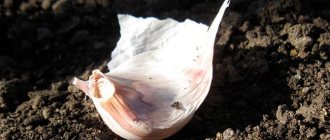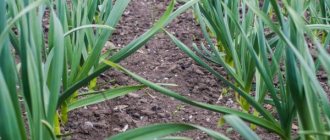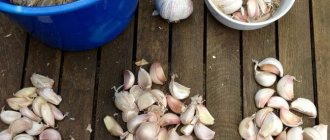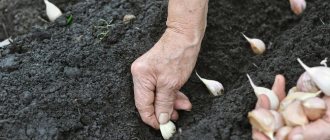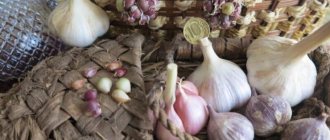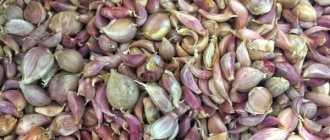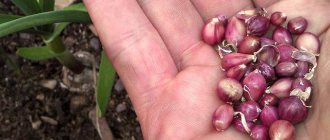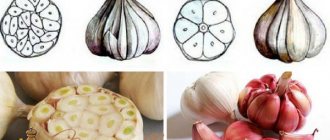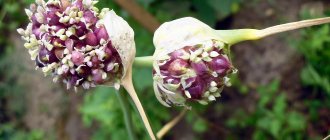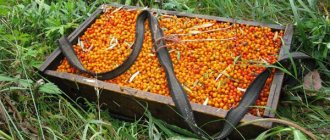After which green manures can garlic be planted?
Garlic can grow on light and neutral soils. Often, to additionally saturate the soil with nutrients and oxygen, special crops, so-called green manures, are planted:
- All grains except barley and rye.
- Leguminous plants.
- Forage grasses, such as clover, alfalfa.
- Mustard.
Planting winter garlic
Important! The vegetable should not be planted after crops that have similar root systems, such as onions. Planting can be done no earlier than 3-4 years.
When to plant winter garlic in the fall: planting dates in the Moscow region
Planting garlic in the fall before winter in the Moscow region is often carried out according to the recommendations of the lunar calendar. According to it, the best time for this procedure is considered to be the period from September 14 to 20. In October, the most favorable days are from the 15th to the 23rd.
In the Moscow region, temperatures drop quickly, so autumn planting is carried out a little earlier than in other regions, until approximately October 20. You need to give the cloves time to take root well before the constant cold weather and not germinate. Later planting can lead to damage to the crop: in the spring, frost-bitten sets will not germinate or will grow weak. Too early will result in seedlings that will not be able to survive the winter safely.
Many gardeners build a garlic planting schedule according to folk traditions. It is traditionally believed that cloves should be planted before October 14, that is, no later than the onset of the Intercession holiday.
Selecting a location
When choosing a place to plant a vegetable, you need to take it seriously and read a number of recommendations:
- The soil for planting should be loose, soft and fertile.
- The site should be slightly elevated to avoid excess moisture after winter.
- If the soil on the site was fertilized with manure before planting garlic, planting is strictly not recommended. The crop will be susceptible to fungal disease and yield will be significantly reduced.
- A sunny area is ideal for intensive growth of the crop.
How to choose a variety and prepare winter garlic for planting
When choosing a variety, you should pay attention to the weather conditions. For the Moscow region, preference should be given to cold-resistant crops. The most popular types are:
- Podmoskovny. It is distinguished by large bulbs and high yield. It is in high demand from local gardeners.
- Lyubasha. The variety has high taste and immunity to diseases, and is often used for the Moscow and Moscow region. It has a powerful root system, which is reflected in the size of the fruit.
- Alcor. The yield is plentiful, the species tolerates temperature changes well, and has moderate resistance to disease.
- Gribovsky. The crop ripens quickly and produces a lot of fruit. Resistantly resists infection by harmful microorganisms and viruses.
- Komsomolets. Garlic tastes pungent and is not susceptible to diseases, including rot. Loves the sun more than other varieties.
- Jagged tooth. The culture is immune to fusarium and has good shelf life for up to 6 months.
Variety Podmoskovny
Gardeners also prefer the following varieties of planting material:
- Broadleaf. The stem of the plant is well developed. The advantage is the absence of arrows.
- Novosibirsk. It produces a lot of fruit and adapts well to sudden changes in temperature.
Popular local varieties
The yield of garlic bulbs depends on adaptation to soil and climate. A win-win option is to grow local varieties. What types are recommended for the Moscow region:
- Bryansk local non-shooting variety of garlic. A mild-sharp spring plant, which is not planted in the Moscow region in winter, but is popular among summer residents. It has a round-flat bulb weighing up to 50 g with a large number of cloves.
- Mid-season Dungan local, not spring. Large onions, 30-50 g each. Number of cloves - from two to nine, average shelf life. Round-flat bulb shape with purple scales.
- Vyatka bolting winter variety of garlic. An onion weighing 60 g with up to nine cloves. It has a pungent taste, the scales are purple with a hint of lilac.
These are the best varieties of garlic for the soils of the Moscow region. The winter variety Lekar is also very popular. It is distinguished by early ripening, lack of arrows and white color of dry scales. The mass of the bulb reaches 50 grams, cloves - 11-16 pieces. The taste is semi-sharp, well used in cooking due to its pleasant aroma. It has good shelf life - up to seven months. It tolerates winter well, is transportable, and produces a yield of just over a kilogram per square meter.
The popularity of garlic is difficult to overestimate. The crop is widespread everywhere, but each region has its own list of winter species; on some soils, only spring garlic produces the best yield. In the Moscow region, the soil is variegated: loam, pebble, forest gray, swamp, swampy, sandy and the most fertile black soil in the south of the region. The variety of winter garlic must be selected not only according to the characteristics of the crop, but also according to the composition of the soil in which the plant will be grown.
Preparing the soil for planting garlic in the fall before winter
It is recommended to plant the crop in an open area that is well heated by the sun. Do not use places where melt water often accumulates. It is necessary to give preference to sandy or loamy soils.
The ground must be thoroughly cleared of weeds and dug up. Humus should be added to it in an amount of at least 1 bucket per 1 square meter. m, nitrogen fertilizers (can be replaced with wood ash). The latter is scattered throughout the area.
Preparing the soil for planting material
After the nutrients have been added to the soil, it is necessary to level the soil using a rake and leave it for several days. After their expiration, you can plant the slices.
Important! Organic matter is applied directly in the process of digging up the soil. It is not recommended to use fresh manure - this can damage the seedlings.
How to plant garlic in open ground in the fall
Planting in the fall in the Moscow region requires compliance with the planting scheme, in particular the frequent placement of garlic in the garden bed. This makes it easier to follow the plant in the spring.
Planting pattern and depth
To ensure crop germination in the spring, you need to know exactly at what depth to plant garlic before winter in regions such as the Moscow region. Most often this is 8 cm. Experienced gardeners use the following calculations when planting: the planting depth of the segment should be twice the size of the planting material itself.
Features of planting garlic cloves in the ground
The scheme for planting winter garlic in the ground in the Moscow region includes the following steps:
- Markings must be made on the previously prepared plot of land to calculate the number of beds.
- Using the marks made, it is necessary to dig trenches up to 12 cm deep. The distance between future beds should be at least 40 cm. This is necessary so that the heads grow large and weeds can be easily removed during weeding.
- The teeth are slightly pressed into the ground with the blunt end down. The interval between them must be 15 cm.
- The top of the trench should be sprinkled with soil and lightly compacted.
Seed material in the trench
After planting the segments, after a few weeks it is necessary to mulch the area. Leaves or spruce branches are used as mulch.
Important! Planting large cloves will allow you to reap a large harvest: the larger they are, the larger the heads will be.
You can also plant garlic seeds in the fall. After the air bulbs appear, they need to be collected. In autumn, trenches up to 6 cm deep are made on pre-prepared soil. Planting material, previously treated with a manganese solution, is sown in them. The seeds are sprinkled with soil and covered.
Further care of the beds
Autumn plant care does not require complex rules. In the spring, after green shoots begin to appear, it is necessary to inspect the area and remove unsprouted cloves.
Cultivation care
For rapid growth, it is important to fertilize the soil in a timely manner. For these purposes, bird droppings can be used, which are diluted in water in the proportion of 1 kg of substance per bucket of water.
It is also necessary to loosen the soil at least 2 times a month, thereby saturating it with oxygen and facilitating the penetration of moisture to the roots.
In the spring, if there is no precipitation, it is necessary to provide the crop with a sufficient amount of moisture. To do this, water the garlic rows at the root.
When shoots appear, it is recommended to remove them, since additional shoots take away nutrients, slow down the growth of the plant and lead to the heads becoming smaller.
Garlic is practically not susceptible to disease, but for prevention it is necessary to dust it with ash. This effect saturates the soil with useful components and reduces the risk of pests.
Is it necessary to cover garlic for the winter in the Moscow region?
Temperatures change quickly in this region, so covering the area is necessary. However, in early spring you should get rid of the shelter. This will not only speed up the sprouting process, but will also prevent the risk of mold.
Garlic shelter in the Moscow region
How to do it right
Covering the beds should begin a few weeks after planting. This procedure is carried out again after the temperature drops, with the onset of the first frosts. Humus mixed with leaves is used as a protective layer. The mixture is laid in an even layer and covered with roofing felt on top. This insulation prevents the risk of tooth damage.
Straw or sawdust can also serve as shelter. Despite the fact that the crop is considered unpretentious, during severe frosts the beds can be damaged, as a result of which seedlings will not appear in the spring.
Growing crops in the Moscow region requires following some recommendations. Despite the fact that the crop is immune to cold and disease, it is necessary to cover the beds in a timely manner.
It is also important to initially select the optimal variety and follow the rules for disinfecting planting material: this will not only speed up the process of shoots appearing in the spring, but will also prevent infection with diseases.
Methods for propagating garlic
The most popular method for propagating garlic is cloves, much less often seeds, or as they are also called, bulbs. It will take two years to grow a full-fledged large head from seeds. In the first year, seeds are planted, from which small bulbs are obtained, and the next year they grow into a full-fledged head with teeth, which can be safely used for planting.
Photo of planting garlic
It is propagation by cloves that is considered the most traditional method, which allows you to get a harvest every year. But it is worth remembering that the quality of the harvest depends on the planting material.
Before planting, the teeth must be prepared. To do this, they are carefully sorted and all damaged, distorted, cracked or limp ones are immediately removed to the side. It is necessary that the clove be hard, intact, without defects and in its outer shell. As soon as the planting material is selected and formed, it must be disinfected. You can do this as follows. In two liters of water, approximately 400 g of ash is diluted. The mixture is boiled over medium heat for about half an hour, cooled, and then the cloves are soaked in it for about 2 hours, no more. Some gardeners who prefer to grow spring garlic sometimes germinate the cloves in advance, but as practice shows, this is not done at all not necessary.
Spring garlic: secrets of planting and growing
To grow spring garlic, planting should be done in the spring - April or May. The most important thing is that there is no snow, and by this time the ground has warmed up to 8-10 degrees. Also, if planting is carried out in dry soil, then upon completion, it will be necessary to water.
So, before you start planting, you need to cut small grooves. The distance between the grooves is usually 15-20 cm, the depth is no more than 6 cm, and the distance between the teeth is 10 cm - this is quite enough. In addition, after planting, it is advisable to mulch the ridge. This will be especially true for regions with hot and dry summers.
The first shoots during spring planting will appear at any temperature, even if there is a sudden frost. If we talk about optimal temperature conditions, they are something like this:
- Up to +10 early on
- From +13 to +22 at the stage of bulb formation
- Up to +30 when the head ripens.
Another important point when cultivating spring garlic is watering. In the first stages it should be abundant and constant, several times a week. As soon as the formation stage begins, watering is reduced by about half, and in case of heavy and constant rains it is stopped altogether in order to avoid excess moisture. Overmoistening is dangerous for garlic because it causes diseases and the bulbs will rot.
Scheme for planting garlic in open ground
It is worth remembering about fertilizing, which is carried out twice during the growing period. The first feeding is done in the spring using cow or bird manure. The proportions are as follows: 1:10 and 1:12, respectively. The second feeding should be done in the summer, usually the end of June - beginning of July. For this, ash is used, which is diluted in water in a proportion of 200 g per 10 liters.
Remember to loosen the soil and pull weeds to ensure better growth. Experienced gardeners strongly recommend resorting to mulching, as it allows you to reduce the frequency of watering, eliminates the need for loosening and protects from the scorching sun.
Winter garlic: secrets of growing in open ground
When planting garlic in winter, the period usually chosen is mid to late October. This is the most optimal time because the garlic has time to take root well before wintering and does not germinate too early.
The bed for planting should be prepared in advance, 2-3 weeks in advance. The preparation itself consists of cutting rows and pouring a small layer of sand or ash (2-3cm) into each row. The sand protects the cloves from contact with the soil and prevents them from rotting.
If we talk about the grooves, then the distance between them should be slightly greater than during spring planting - from 20 to 25 cm, the depth is about 7-8 cm, and the pitch between the cloves is no more than 10 cm. It is most convenient to plant when the soil is slightly moist - This allows you to place the cloves at the desired depth without much effort.
After planting, the bed is usually covered with mulch, but in places where winters are snowy, this is not necessary. If we talk about regions where there is practically no snow and frosts are severe, then mulching is simply necessary. As an alternative, you can use film.
In general, garlic planted in winter has increased resistance to cold and can withstand frosts down to -25 degrees. In spring and summer, before harvesting, it is necessary to provide proper care, following the example of spring garlic, that is, remove weeds, fertilize, etc. To get a good harvest, you should remove the arrows on the stems. Now you know all the features of growing winter garlic, so you can try planting it on your own plot.
What causes garlic and its pests?
Garlic, like any crop, has pests, and it gets sick just like other crops. Below, we will describe the most common diseases that can prevent you from growing a good and healthy crop.
Fusarium Or, as it is also called, bottom rot. A fungal disease that can be recognized by yellowing leaves and dying roots. If you take the head out of the ground, you can find a white or slightly pinkish coating on it, which is what causes rotting.
Photo of healthy garlic
Bacterial rot is another well-known disease that affects the cloves themselves. Small brown sores form on them, and a distinct musty odor appears.
Downy mildew Another name is downy mildew. The main symptoms are the formation of a gray coating and drying out of the feathers.
Watch the video: How to deal with garlic pests
White rot This fungal disease can be recognized by yellow dying leaves and a white coating on the roots and head.
Black mold Another name is stemphylliosis. A rather insidious disease that often leads to a decrease in yield. It can be recognized by the appearance of yellow spots on the leaves, which later become covered with black mold, in fact, hence the name.
In general, a lot depends primarily on the quality of the planting material - the better it is, the lower the risk of disease. If we talk about pests, garlic is most often affected by flies and their larvae, as well as various onion thrips, nematodes, mites and moths. You can fight them with the help of special drugs.
If you follow the tips and suggestions from this article, then the question: “How to grow healthy garlic, and even large heads?” will no longer arise. The harvest will always delight you with its quality and size, and in winter it will protect you from diseases and viruses.
Also read:
- How to grow perennial plants for your garden
- How to plant ranunculus correctly. All the secrets of growing
- How to care for strawberries in the spring for a good harvest
- Treatment of currants in spring against diseases and pests
- How to make a drip irrigation system with your own hands
- What annual flowers bloom all summer. Catalog…
- Planting low-growing perennial flowers yourself
- How to grow a beautiful cypress kochia bush in your dacha
